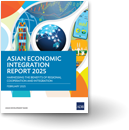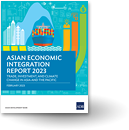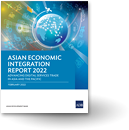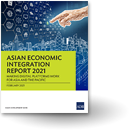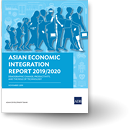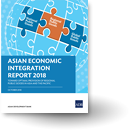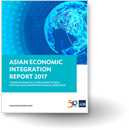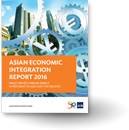
-
- Themes
- Database
- AEIR Data Catalogue
- Free Trade Agreements
- Macroeconomic database:
- Regional Cooperation and Integration database:
- Daily Market Watch
- Resources
- Events
- Economies
- Central Asia
- East Asia
- Oceania
- South Asia
- Southeast Asia
- The Pacific
- COVID-19


Asian Economic Integration Report 2015
How Can Special Economic Zones Catalyze Economic Development?
The Asian Economic Integration Report 2015 examines current trends in trade, finance, migration, remittances and other economic activities in the region, with a special chapter on the role of special economic zones (SEZs). If done right, SEZs can become drivers for increased trade, foreign direct investment (FDI), and better economic policymaking and reforms. Moreover, as countries develop, areas with SEZs can be transformed from mere manufacturing sites, to become hubs for innovation and modern services. more about the AEIR
ADB launched the Asian Economic Integration Report (AEIR) 2015 at the Lee Kuan Yew School of Public Policy on 8 December 2015. ADB’s Chief Economist Shang-Jin Wei delivered the opening remarks, while ERCI Principal Economist Jong Woo Kang presented the key findings of the Report.
The Asian Economic Integration Report (AEIR) is an annual review of Asia’s regional economic cooperation and integration. This latest issue includes a special chapter, How Can Special Economic Zones Catalyze Economic Development?
see video“Asia’s income elasticity of trade declined from 2.69 before the global financial crisis (GFC) to 1.30 afterwards...”
“Regional trade blocs such as the Trans-Pacific Partnership and the proposed Regional Comprehensive Economic Partnership could faciliate freer trade if supported through open, flexible accession.”
“Asia’s outward FDI increased faster than inward FDI—growing 45.3% in 2014 compared with 2010 led by both the region’s high income and emerging market economies.”
“Economies that rely heavily on remittances for income also tend to experience high volatility in remittance inflows. These economies should continue to pursue industrialization and economic diversification to make their economies more resilient and provide more domestic job opportunities.”
“Effective SEZs must be an integral part of dynamic national development strategies and evolve as economies develop by transforming from manufacturing bases to technological platforms for innovation and modern services.”
Contents:
Download chapter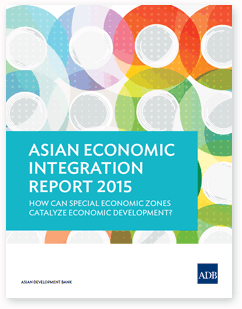
Cover and highlights
Download chapter
Progress in Regional Cooperation and Integration (Asian Economies under Changing Global Environment)
- Asian Economies under Changing Global Environment
- Updates on Trade and Investment Integration
- Updates on Financial Integration
- Updates on Movement of People
- Updates on Trade Policy
Download chapter
Special Chapter: How Can Special Economic Zones Catalyze Economic Development?
- The Rise of the Zones: Origin, Objectives, and Diffusion
- Varieties of Zones: Modalities, Ownership and Evolution
- Success Outcomes and Drivers of SEZ Performance
- Development Strategy and Institutions
- Economic Impact of SEZs
- Learning from Experience: Preconditions and Policies
- The Future of Zones
- Annex A: Methodology for Coding Data for Regressions
- Annex B: Country Case Studies
- References
Download chapter
Statistical Appendix
- Regional Integration IndicatorsAsia
- Trade ShareAsia
- FTA StatusAsia
- Time to Export and ImportAsia
- Logistics Performance IndexAsia
- Cross-Border Equity Holdings ShareAsia
- Cross-Border Bond Holdings ShareAsia
- FDI Inflow ShareAsia
- Remittance Inflows ShareAsia
- Outbound Migration ShareAsia
- Outbound Tourism ShareAsia
AEIR Archives:
ASIA REGIONAL INTEGRATION CENTER
© 2015 Asian Development Bank. All rights reserved. Reproduction in whole or in part without permission is prohibited.
About us
The Asia Regional Integration Center (ARIC) is an ongoing technical assistance project of the Economic Research and Development Impact Department (ERDI). Following the 1997/98 Asian financial crisis and the contagion evident around the region, ADB was asked to use its knowledge-based expertise to help monitor the recovery and report objectively on potential vulnerabilities and policy solutions. With the ASEAN+3 process just starting, ADB provided technical assistance beginning in 1999—to create the Asia Recovery Information Center, the precursor to ARIC.
Contact us
Please help us improve the ARIC website by sending us your comments. These may be on content, (e.g., articles posted on or for which links are provided in the ARIC website), website structure (e.g., do you find ARIC's sections useful?), ease of navigation, or even page design and layout.
Send all your comments to: aric_info[at]adb.org
Send all your comments to: aric_info[at]adb.org
Quick links
Other ADB sites:
ADB Regional Cooperation and Integration | Asian Bonds Online | Asian Development Bank Institute | RTA Exchange
Other ADB sites:
ADB Regional Cooperation and Integration | Asian Bonds Online | Asian Development Bank Institute | RTA Exchange
